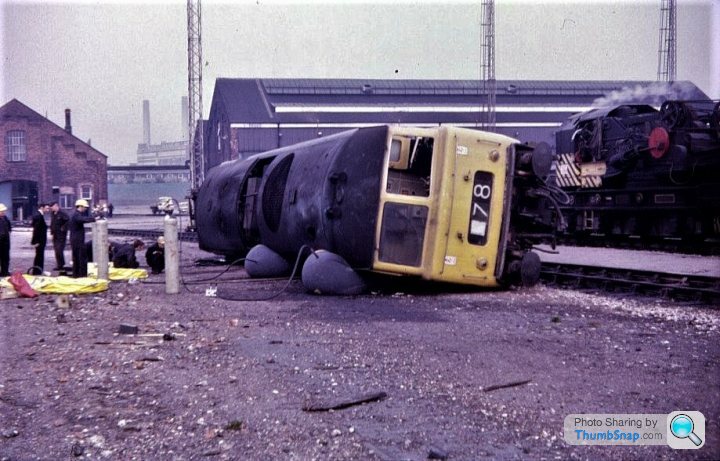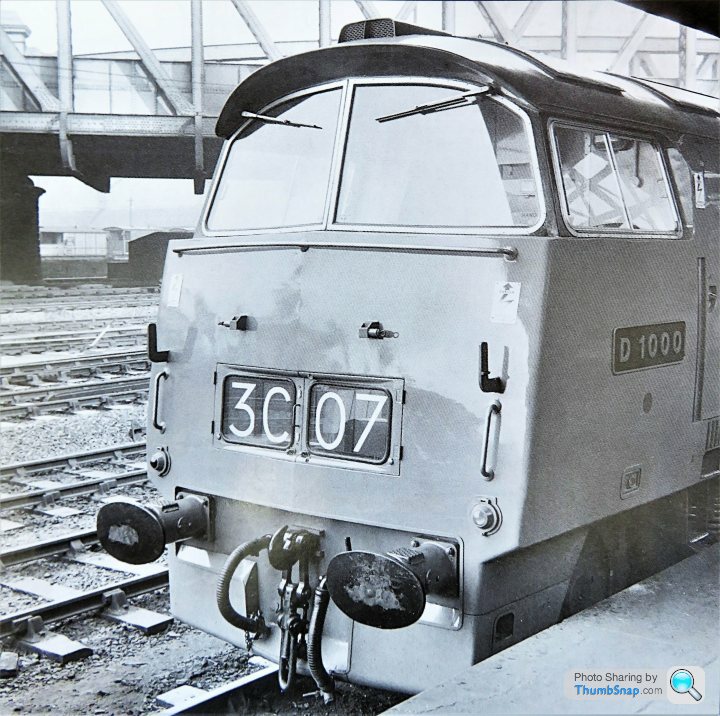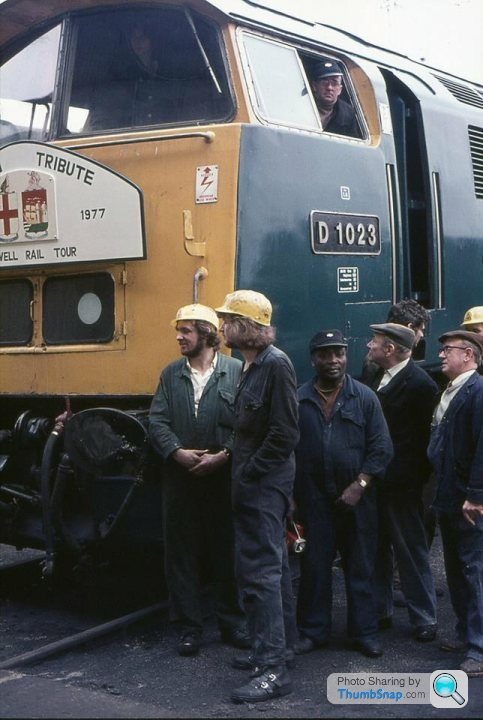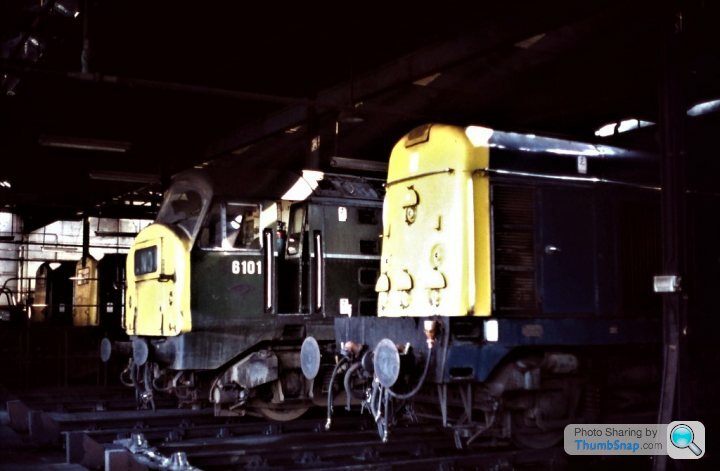Loco sheds and other railway buildings...
Discussion
Bert Cheese said:
Tyre Smoke said:
Might already have been answered, were all the Westerns named? Were they all (that were named) Western XXXXXXXX?
The story goes that this came about thanks to an uncredited secretary attending the various meetings to decide the names of the WR's premier new diesels due out of Swindon...they wanted to move away from the military theme of the D8xx Warships but were struggling to find a scheme grand enough.Many suggestions had been knocked back, the re-use of classic GWR names such as castles, kings, birds, and places of interest* on the region being among them but it had to fit with the ethos of the stuffed shirts on the WR board basically...many of who were partisan ex-GWR types.
After yet another stalemate she apparently said in exasperation something along the lines of "Oh for Heavens sake why don't you just call them all Western something then"
Of course this might just be an urban trainspotters myth...
- There was I believe an artists impression issued by Swindon of D1000 named Cheddar Gorge with large individual letters shortly before the final names were decided on.
Black’s initial plan was for the whole class to be painted in turquoise blue with red buffer beams, but this was rejected in favour of the all over maroon livery which he loathed right from the start. In August ‘66 though D1030 was the first one to be painted blue and he sort of got his wish, the shade of blue chosen was darker than his earlier sketches but D1030 did have the red buffer beams. By late ‘66 / early ‘67 you could see a mix of maroon, green and blue Westerns, green and maroon Warships plus mostly green and blue Hymeks on a daily basis on the Western Region. Two of the five D600 Warships were also painted blue in this period.
Edited by P5BNij on Tuesday 22 February 20:45
markymarkthree said:
Talking Westerns. For my sins i was a spotter back in the late 60s early 70s. Unfortunately for me i lived in Surrey so we didn't get to see a lot of the great diesels in the Southern region. However we did get to see 1051 Western Ambassador on a fairly regular basis at Claphan jct, which even back then we thought was a bit weird. Can you throw any light on that ?
As an aside i had an Aunt who lived near Bristol (Blagdon) so i got to be dropped off at Temple Meads quite a lot which gave me a good fix of WR diesels.
Sorry, missed this earlier - Western Region hydraulics appeared at Clapham quite regularly, there were inter-regional transfer freights between Acton, Old Oak and Norwood and between 1964 and 1971 the Waterloo - Exeter trains were in the hands of Warships. In the early '70s there were also stone trains from the Westbury area coming up to south west London for motorway construction. Westerns and the last few Warships were regulars on this until the end of 1972.As an aside i had an Aunt who lived near Bristol (Blagdon) so i got to be dropped off at Temple Meads quite a lot which gave me a good fix of WR diesels.
Stevepolly said:
Hope this is allowed, if not please delete.
It's a photo by Aurthur Ingram,
As I dont have any of my own I thought I'd share this one of a Deltic on it's way to the Science museum.

All contributions are welcome Steve - lovely old pic that It's a photo by Aurthur Ingram,
As I dont have any of my own I thought I'd share this one of a Deltic on it's way to the Science museum.


On a similar theme, here's Stanier Pacific 46235 'City Of Birmingham' arriving at its namesake, after a going over at Crewe Works....


And sticking with Brum, some photos from the 'Saltey Seagulls' facebook page taken by Paul Barrett....
 [url]
[url] |https://thumbsnap.com/4yR6ccMQ[/url]
|https://thumbsnap.com/4yR6ccMQ[/url]







Blimey I remember those long thin payslips, my original pay number at Stonebridge Park when I started was 9000, a proper Deltic number!
I mentioned working down the Lickey in an earlier post - this is the view from the top at Blackwell before taking the plunge....

47 534 reaches the top after the two mile climb at 1 in 37 from Bromsgrove in December 1981....

I mentioned working down the Lickey in an earlier post - this is the view from the top at Blackwell before taking the plunge....

47 534 reaches the top after the two mile climb at 1 in 37 from Bromsgrove in December 1981....

Some more bits 'n' bobs while I wait for some paint to dry...
Brand new 25 at Derby in '67...

A mixed bag at Peterborough Depot in '79...

46 029 on a 'liner coming out of Kings X Goods Yard in '76...

Keepsakes...

4468 'Mallard' at Peterborough after the famous record breaking run down Stoke Bank on 3rd July 1938...

D1011 'Western Thunderer' at Banbury on its way back to Paddington in June 1975...

Brand new 25 at Derby in '67...

A mixed bag at Peterborough Depot in '79...

46 029 on a 'liner coming out of Kings X Goods Yard in '76...

Keepsakes...

4468 'Mallard' at Peterborough after the famous record breaking run down Stoke Bank on 3rd July 1938...

D1011 'Western Thunderer' at Banbury on its way back to Paddington in June 1975...

mfmman said:
To add to all the Western photos, I was looking at a Bristol rail website and found this

Description is "Western D1072 after suffering a mishap at Bath Road Depot." Taken from Bristol Rail Archive and is credited to a Jeff Lewis
Not a mishap, but a rerailing exercise for the Bath Road breakdown crew...
Description is "Western D1072 after suffering a mishap at Bath Road Depot." Taken from Bristol Rail Archive and is credited to a Jeff Lewis

In late '73 the Old Oak breakdown gang did a similar exercise with Hymek D7100...


Some more Western Region London Division nostalgia from the '60s and '70s...



























velocemitch said:
Cracking stuff P5 keep it up, which ever region.
I must find time to dig through my stuff and scan some.
Thanks and will do - please post whatever you have I must find time to dig through my stuff and scan some.

The Blue Pullman and its early demise was mentioned a few posts back - the five sets entered service in September 1960 and lasted until May 1973 when the very last service from Paddington to Swansea ran, sadly all thirty six vehicles were scrapped but some of the fittings and furniture managed to survive in private hands. At one point the BR Board considered selling the entire lot to Yugoslavian Railways but a price couldn't be agreed on so they were scrapped.
Kevin Robinson and Mike Smith's books on the subject are well worth a look....
https://www.amazon.co.uk/Blue-Pullman-Story-Revise...
https://www.amazon.co.uk/Blue-Pullman-Pictorial-Ke...
2xChevrons said:
It's always amazing to see how quickly nature reclaims a site once it stops being in regular use - well within living memory and it's already 'growing in' like some remnant of a medieval field system.
Of course, there are some bits of the still-active railway network that aren't far behind when it comes to the 'green tunnel'. I know there are perfectly good reasons why the permanent way/formation isn't as neatly kept as it once was but it's still a shame to see.
Roundhouses were more expensive to build and even more difficult and expensive to expand if your locomotives grew to large and/or heavy for the existing building and turntable. A shed was easier to expand, and with the building and the turntable separated it was possible to rebuild one and not the other. One reason why the Midland kept building smaller, less powerful locomotives in the 20th century when its rivals were all going for modern 'big engines' was because they would have had to rebuild all their roundhouses to accommodate them. The GWR was lucky in that many of its most important depots with roundhouses were designed around broad gauge engines so there was room for larger engines.
Some of the Churchward designed roundhouses on the GWR were designed to be expanded with bricked up entrances in the rear walls, two which spring to mind are Old Oak and Tyseley, alas though the extensions were never built. The old Midland Railway roundhouse at Wellingborough still stands and is now listed, for a while it became a shoe factory but is now being transformed into a museum.Of course, there are some bits of the still-active railway network that aren't far behind when it comes to the 'green tunnel'. I know there are perfectly good reasons why the permanent way/formation isn't as neatly kept as it once was but it's still a shame to see.
DickyC said:
Last used in the late sixties as far as I can find out. Now part of the Trans Pennine Trail.
If it was a question in a quiz, I would have said turntables were housed in loco sheds. And I would have been wrong.
/not a dyed-in-the-wool train spotter
Roundhouses were the exception rather than the rule in Britain. Our railways quickly started favouring a longitudinal multi-road shed with a separate turntable from the mid-19th century. The Midland and the Great Western stayed wedded to roundhouses for a much longer period and still built new ones into the 20th century. That's why, unusually amongst pre-grouping railway companies, MR and GWR locos had their numbers painted on their fronts (on the smokebox door on Midland engines, on the buffer beam on GWR ones) - so they could be identified from the front when engines were arranged around a turntable. On other railways, engines would be arrayed in lines in a shed, so shed staff and crews would be approaching them from the side, making it more necessary to have the numbers on the cab/tender/tank sides. If it was a question in a quiz, I would have said turntables were housed in loco sheds. And I would have been wrong.
/not a dyed-in-the-wool train spotter
Roundhouses were more expensive to build and even more difficult and expensive to expand if your locomotives grew to large and/or heavy for the existing building and turntable. A shed was easier to expand, and with the building and the turntable separated it was possible to rebuild one and not the other. One reason why the Midland kept building smaller, less powerful locomotives in the 20th century when its rivals were all going for modern 'big engines' was because they would have had to rebuild all their roundhouses to accommodate them. The GWR was lucky in that many of its most important depots with roundhouses were designed around broad gauge engines so there was room for larger engines.
An unusual style roundhouse on the GWR was Swindon, which had a turntable inside at one end with straight roads at the other end.
Just a few years ago the layout at Banbury was remodelled and a new unit depot was built on the site of the old steam shed, the turntable pit was still intact, as were parts of the coaling stage brickwork for many years but the table pit was filled in once the new depot had been built.
Nice find Dicky

Edited by P5BNij on Tuesday 15th March 14:51
DickyC said:
P5BNij said:
Nice find Dicky 
I'm in Manchester on Granddaughter #1 Duty. Much time on hands. 

Could the scope of the thread include the smoldering ruins of the Manchester Ship Canal Railway and my musings thereto?

RB Will said:
One of Swindon’s turntables through the years. It is just a car park ornament now 






The building in the background was part of the works and has since been a decent bar, then Italian restaurant and is now a church!
The story behind Colin Massingham's purchase of D818 was almost accidental - he and another enthusiast had initially bought Class 22 D6319, it had been given a very expensive complete overhaul at Swindon in the Spring / Summer of 1971 but only lasted twelve weeks in traffic before being withdrawn in September, they chose it because of it's condition and paid for it promptly. Unfortunately due to a cock up the order was given to cut it up, so as compensation Colin and his chum were offered D818 instead.






The building in the background was part of the works and has since been a decent bar, then Italian restaurant and is now a church!
velocemitch said:
Great post and very enlightening. Railway enthusiast do get very tribal about things I know looking back I always saw the GWR almost as an enemy for some reason. My leanings were LMS, then LNER, Southern (I loved the Bullied innovations) then GWR.
You post does explain well why the GWR went there own way in the grouping era, doesn't to be fair explain why they persisted into the Diesel era. I'm sure that was because they could, rather than because they should.
It persisted into the diesel era because the top WR engineers and management agreed that good hill climbing capabilities were required of the new locomotive fleet, they looked to Germany for experience and inspiration and used the V200 diesel hydraulics as the basis for what they wanted. It's a minor miracle that they managed to pretty much achieve this with the D8XX Warships after the disappointment encountered with the five D6XXs which were considered too heavy at the time (although this in turn worked out for the better as after 1962 the five D6XX spent most of their time on freight work west of Newton Abbot and the brake force available allowed them to take some considerable loads over the South Devon banks). You post does explain well why the GWR went there own way in the grouping era, doesn't to be fair explain why they persisted into the Diesel era. I'm sure that was because they could, rather than because they should.
A huge problem they had to overcome was scaling everything in the V200s down to the space available in the much smaller D8XX bodyshell which itself was quite sophisticated compared to the EE and Sulzer Type 4s being built at the time. The shell started out with two long chassis tubes onto which were welded various loadbearing crossmembers, then a stressed skin bodyshell was built up above footplate level. The Westerns were also built this way but the D63XXs and the Hymeks were built in the conventional style.
Gareth1974 said:
P5BNij said:
I bet it sounded nice whistling along - it looks like somewhere between Armitage and Lichfield to me 
Just by the old Hademore crossing, not much noise as it was on block to a 350 which had just called at Lichfield.

A nice atmospheric shot taken at Perth in the '60s....

DickyC said:

Dropped off my car in the back of beyond at a diagnostic specialist and saw a remnant of the LVR, The Lambourn Valley Railway, on the track to his house.
When I mentioned it to him he said he'd lived thereabouts since he was seven when his father got a job on a farm and he had watched the LVR's last train - with a steam locomotive - as it went along removing the track as it went. The job took long enough for the workers to recognise him and he was once invited up on to the footplate. He then told me he'd had the best childhood.





Gassing Station | Boats, Planes & Trains | Top of Page | What's New | My Stuff





























